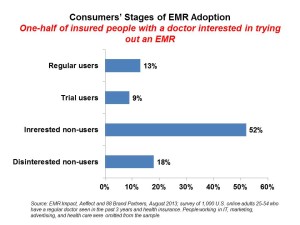 1 in two people who are insured and have a regular doctor are interested in trying out an electronic medical record. But they need a doctor or nurse to suggest this, and they need it to be easy to use.
1 in two people who are insured and have a regular doctor are interested in trying out an electronic medical record. But they need a doctor or nurse to suggest this, and they need it to be easy to use.
The EMR Impact survey was conducted by Aeffect and 88 Brand Partners to assess 1,000 U.S. online consumers’ views on electronic medical records (EMRs): specifically, how do insured American adults (age 25 to 55 who have seen their regular physician in the past 3 years) view accessing their personal health information via EMRs?
Among this population segment, 1 in 4 people (24%) have accessed their EMR online, via web or mobile platform. Across this population, Aeffect and 88 Brand found that one-half of people want to try out an EMR, shown in the graph. The four stages of EHR adoption the poll segmented are:
- Disinterested non users, 18% of the insured population with doctors: these folks have never tried and aren’t interested in accessing an EMR. They are less likely to think EMRs are more accurate than their paper files, and don’t perceive a need to access their health info outside of a doctor’s office. They are more concerned about information security and are least likely to do shopping and banking online. They skew older, with 63% of this cohort over 40 years of age.
- Interested non users, 52% of the insured population with doctors: this is the ready-to-adopt group that’s never tried out an EMR but are interested. They’re less satisfied with their doctors compared with other consumers surveyed. 49% said they would consider switching to doctors using an EMR in their practice. Over one-half of this group has doctors who already use an EMR, but 42% don’t know where or how to access their own.
- Trial users, 9% of the insured population with doctors: this group has tried an EMR once or twice, over one-third in the past 6 months. This group has the highest percent of women.
- Regular users represent 13% of the insured population with doctors: 35% of these people have been using an EMR for over 3 years. They like to email their doctor more than use the telephone or see their physician face-to-face. They are also more caregiving, with 1 in 3 of this group providing care to a parent or adult family member. They’re also more likely to go online for Rx refills and to check lab test results. Two-thirds say having an EMR is an influence in selecting their physician.
What are the benefits of EMRs, according to consumers using them? Checking records or test results, making and confirming appointments and lab tests, and requesting Rx refills. Another positive benefit for physicians is that nearly one-half of consumers have more positive impressions of doctors who use EMRs. EMR using consumers also perceive that EMRs improve communication with physicians, enable better coordination of care, and inspire more confidence in the care received.
Barriers to using EMRs found in this survey were among consumers with doctors in solo or private practice, and living in rural geographies. A key barrier was also among consumers whose doctors or nurses didn’t encourage use of the EMR. This population of consumers who don’t use EMRs also perceive that EMRs aren’t easier to use than paper, nor would be secure or reduce medical errors.
Health Populi’s Hot Points: Who’s most likely to seek trial of an EMR? Survey says….people age 31-40 with kids, and older users with children under 18. The strongest predictor for consumer EMR adoption, Aeffect and 88 Brand say, is that the EMR makes it easier for “you” to get your health information. Of secondary importance: security and error reduction.
For those who aren’t yet using an EMR, what most will promote trial of an EMR? A recommendation from your doctor or your health system. Trust and authenticity are precursors to health engagement by consumers. The doctor and “my” health system continue to rank most highly on the trust and authenticity roster for health.
Once recommended, the health consumer needs that easy button to enable a smooth, engaging, delightful experience in accessing health information to make it stick.
On that score (pun intended), today the NFL union announced a kind of easy button for football players: the Uber app that enables users to click and summon a driver to pick them up. Coined as “everyone’s private driver,” the Uber app is seen by the NFL as a way to keep drunk football players from driving drunk – wherever they are. The GPS-enabled app enables drivers to pick up footballers wherever they are, even when the player doesn’t know the exact address. The New York Times reports that NFL players will be offered $200 in credits as an incentive to use the service. The Uber app is already used by the San Francisco Giants and the Minnesota Timberwolves.
Will consumers need a financial inducement to use EMRs? They may already have one and don’t realize it: we’re paying more health costs out-of-pocket, and learning how to use high deductible health plans. For increasingly health financially literate insured Americans, that may be another reason to access our health information, especially to square our clinical encounters with our financial health accounts. Here, Uber meets Mint.com for health.




 Thank you Feedspot for
Thank you Feedspot for  Jane was named as a member of
Jane was named as a member of  I'm gobsmackingly happy to see my research cited in a new, landmark book from the National Academy of Medicine on
I'm gobsmackingly happy to see my research cited in a new, landmark book from the National Academy of Medicine on